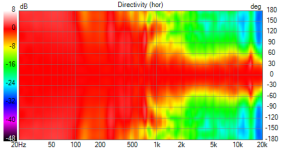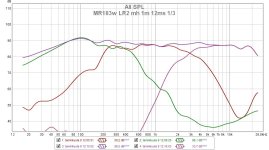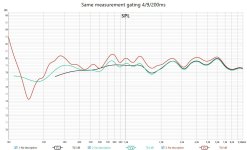Thanks for your reply. Very close! Hornresp say 44.4 hz. What would you say I am sacrifiicing with this large port? The need for heavy eq, wreaking havoc on my phase response/sound quality?Cannot answer other questions, only can add to them, as want to see full your config, but... For me ~3,6cm diam port is adequate. Maybe 4cm is the upper limit, as there is not much turbulence when used at the nearfield levels. I use smth like 55-65Hz tuning, still haven't firmly decided which sounds best, yours is... ~43Hz, I think this is overkill for this driver. But have no idea about your DSP settings
EDIT: oops, with port volume included probably ~45Hz?
Thanks for your reply. Very close! Hornresp say 44.4 hz. What would you say I am sacrifiicing with this large port? The need for heavy eq, wreaking havoc on my phase response/sound quality?
With low tuning and boosted lows with DSP - maybe physical driver damage? Xmax is not huge. Everything else has personal taste thing. Bigger ports - lower freq self-resonance. If it is in front - you can hear leaking 200-1500Hz artefacts from it. The leakage is bigger with bigger diam ports. I think I rarely play music at the levels when big ports are needed because of turbulence, so YMMV.
You still have DSP, so you can control pretty much everything, but if the DSP is in signal path before amp and is not with amp 2in1 probably DSP processor will not have configuration option at which level to reduce low freq output
I don't see any comparison, certainly not in any way I can understand what and where the difference may be.
In #133 post there are 2 freq responses: top is with PKAudio watermark, bottom is mine. Both are the same crossover of PKAudio. With his measurements the freq line is more or less neutral, with mine - very hot high end. Listening confirms that, but... it is not THAT hot. Anyway, I have mic problem and my baffle is different
This is the part that makes it a less than ideal way to make a comparison. Just compare the raw traces without any fitering to get the most useful view of what is different.Both are the same crossover of PKAudio.
I'd say: check the linearity of your measuring equipment without the microphone by doing a loopback test including the amp (and a -20dB pad on the output of that one). The deviation is possibly coming from a combination of differences in baffle step and nonlinearity of your microphone, but it -all in all- is a strange difference, being so gradually different. Make sure no Windows audio setting is messing things up.In #133 post there are 2 freq responses: top is with PKAudio watermark, bottom is mine. Both are the same crossover of PKAudio. With his measurements the freq line is more or less neutral, with mine - very hot high end. Listening confirms that, but... it is not THAT hot. Anyway, I have mic problem and my baffle is different
Are those responses at post #133 measurements or just simulations based on some individual driver measurements copied to VituixCAD? Many possible causes for the difference...
Are those responses at post #133 measurements or just simulations based on some individual driver measurements copied to VituixCAD? Many possible causes for the difference...
PKAudio did his measurements on his baffle and his cabinet, which I have no idea about, and I did my measurements on mine. My measurements are on ~4,6ms gating. Baffle is "IKEA bowl" attached to cuboid. Internals are close to golden section ad I used various internal volumes, that one is, I think, 8.2L .
Then I used the copied crossover PKAudio used on his. The result is on #133 mine and his. Personal opinion - too much sibilance(s) and little too hot highs
Ok, such short gating shows lower bass spl than long gating. As well cuboid "baffle" has more loss than "normal" box with flat baffle.
As well cuboid "baffle" has more loss than "normal" box with flat baffle.
Maybe you don't understand: cuboid is "normal box with flat baffle". In my case baffle is closer to ikea bowl, it is half sphere, attached to classic rectangular box, which has a name - cuboid. So, it is far closer to sphere, than to classic box.
Ok, such short gating shows lower bass spl than long gating.
I will try that, t.y. This driver has weak bass, I am pretty sure about this.
A round baffle like that will have the most loss of any baffle geometry or shape, being its a minimal baffle design and has the widest dispersion of any shape baffle. It will have a steady 6 dB rise up to the corresponding diameter of cone circumference, then level out (not considering the driver's own FR). I often use a second shaded driver to level out the baffle step loss.
A round baffle like that will have the most loss of any baffle geometry or shape, being its a minimal baffle design and has the widest dispersion of any shape baffle. It will have a steady 6 dB rise up to the corresponding diameter of cone circumference, then level out (not considering the driver's own FR). I often use a second shaded driver to level out the baffle step loss.
Yes, I agree, but this particular driver was tested with ~28cm half-sphere and ~21cm diameter half-sphere baffles - 21cm sounded MUCH better. Measurements were done separate with every baffle and crossover type was the same, but some value correction was applied. I have a feeling, that for the tweeter is detrimental to have wider waveguide than the cone of the woofer. Also the lower mids of 1.5-2kHz sounded better with more narrow baffle
But please stay close to topic: if someone would like to test PKAudio crossover - how it sound to you? And what baffle and what cabinet you used?
second shaded driver
profiguy, what is this? Never heard about the name of it. It is a name of 2.5 woofer?
Yes, its essential a supplemental driver only covering the lower part of the FR to make up for baffle step, like the lower woofer in a 2.5 way design. If you want decent bass using smaller drivers on small baffles, you will need a .5 driver to fill in the low end.
Yes, I agree, but this particular driver was tested with ~28cm half-sphere and ~21cm diameter half-sphere baffles - 21cm sounded MUCH better.
Let me recite Olson (AES November 1951...) once more. The half sphere isn't exactly a favourable shape for a loudspeaker.
diyaudio has many threads of spherical enclosures, most with fullrange or coaxial.
My case https://www.diyaudio.com/community/threads/seas-mr18-3-way.322839/
I didn't save individual drivers' dispersion measurements. The midwoofer was relatively easy to eq.


An example of the effect of short gating to bass spl

I thought I should post pictures of my first build.
Project was inspired by Cabasse and the curves employed in B&W 800 series, although on a much smaller budget. Had the idea to use bowls, Ikea had the wooden Blanda which seemed perfect. After scouring the net, found several others using these, although none using the 28cm versions. Design is an active 2 way design.

First completed photo (no tweeter), initially using Zero class T amps.
Current incarnation, using rotel 6 channel amp, channel for tweeter and mid...
Project was inspired by Cabasse and the curves employed in B&W 800 series, although on a much smaller budget. Had the idea to use bowls, Ikea had the wooden Blanda which seemed perfect. After scouring the net, found several others using these, although none using the 28cm versions. Design is an active 2 way design.
First completed photo (no tweeter), initially using Zero class T amps.
An externally hosted image should be here but it was not working when we last tested it.
Current incarnation, using rotel 6 channel amp, channel for tweeter and mid...
My case https://www.diyaudio.com/community/threads/seas-mr18-3-way.322839/
I didn't save individual drivers' dispersion measurements. The midwoofer was relatively easy to eq.


An example of the effect of short gating to bass spl

View attachment 1376848
Let me recite Olson (AES November 1951...) once more. The half sphere isn't exactly a favourable shape for a loudspeaker.
Half sphere connected to cuboid, so it is a hybrid between full sphere or even "droplet" type, like B&W Nautilus AND classic rounded edges cuboid. I mentioned that in #167. In other words, you take classic box, add a small bowl on front and put driver in there. And the measurements show very gradual change from 0 to 180 degrees, no signs of heavy diffraction.
It is NOT a classic half-sphere with flat back - that thing probably is awful from ~90 to 180 degrees.
Played for few days both, so the narrower version of this sounded better. Just better. More point-source and clearer, crisper.
Last edited:
I would suspect some interference at λ/2=π/2.r and multiples, if you put the driver in the middle of the bowl. But I don’t know if it would be bothersome.In other words, you take classic box, add a small bowl on front and put driver in there.
For use in a 3 way design, is there a good reason to choose the 5" over the slightly more sensitive 6"? The smaller driver seems to be a more popular choice in designs I've seen online (both DIY and commercial ie Sigberg Audio).
Sica's measurements look like the 6" has slightly rougher tweeter response and some issues around 3.5-4.5k for the mid, but PKAudio's measurements at the start of this thread show some different issues including a decent dip around 3-3.5kg on the 5" tweeter. I assume these discrepancies are largely due to a difference in measurement conditions (eg baffle).
Sica's measurements look like the 6" has slightly rougher tweeter response and some issues around 3.5-4.5k for the mid, but PKAudio's measurements at the start of this thread show some different issues including a decent dip around 3-3.5kg on the 5" tweeter. I assume these discrepancies are largely due to a difference in measurement conditions (eg baffle).
Yes depend on the woofer and its sensitivity, its crossover frequency etc.. your needs !For use in a 3 way design, is there a good reason to choose the 5" over the slightly more sensitive 6"?
Here is my take on Sica Coax 5”. Paired with B&C 51ndl.
Cabinet is old B&O that I sacrificed from rain on the street. Then enforced and added front grill attached with magnets.
I have made inner cabinet for the Coax. Takes to much volume, so B&C is limited because of only some 7-8 liters of volume.
It was my first serious take with VituixCAD. It took many iterations before I was happy with sound. Global EQ could of course be removed and also pictures of simulation is at 20 degree.
Maybe because of my room, but In this build I found it important to tilt power response downwards quite a bit from 6000 hz and up. Else treble was to hard to my liking.





Cabinet is old B&O that I sacrificed from rain on the street. Then enforced and added front grill attached with magnets.
I have made inner cabinet for the Coax. Takes to much volume, so B&C is limited because of only some 7-8 liters of volume.
It was my first serious take with VituixCAD. It took many iterations before I was happy with sound. Global EQ could of course be removed and also pictures of simulation is at 20 degree.
Maybe because of my room, but In this build I found it important to tilt power response downwards quite a bit from 6000 hz and up. Else treble was to hard to my liking.
Last edited:
- Home
- Loudspeakers
- Multi-Way
- Sica 5" and 6" hifi coaxials measurements